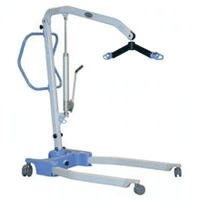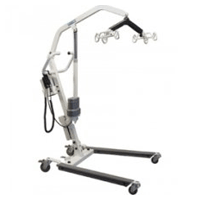Patient lifts, frequently used both in health care centers and in home care situations, make the process of mobilizing and transporting an otherwise immobile patient much safer for both the patient and the caregiver – especially when compared to trying to physically move a patient without any type of assistance.
Because of different needs and varying frequencies of use, there are different grades of patient lifts. Some are designed and constructed for rigorous use in hospitals, nursing homes, rehabilitation centers, and other health care practices. It is not unusual for professional healthcare facilities to utilize permanently mounted overhead patient lifts.
However, when it comes to convenience and home care special needs, mobile-type patient lifts are much more common. Mobile patient lifts are a huge help to at-home caregivers who need a safe way to mobilize and transport patients for numerous specific care needs.
With mobile home-care patient lifts, it has been common to rent the equipment, instead of actually purchasing it outright. Medicare generally only insures the cost of rental of a patient lift, not a purchase. That said, there are several situations when buying the equipment is not only necessary, but also more affordable in the long run. Let’s take an in-depth look at the most common types of patient lifts below.
Manual Lifts
It can be somewhat confusing to see the “manual” category of patient lifts used because it very rarely describes the actual function of the lifts. True manual lifts are becoming increasingly rare, as hydraulically-enhanced patient lifts make the task so much easier. In fact, when the term “manual” patient lift is used, it almost always refers to lifts from the category of hydraulic patient lifts. Again, please understand that most lifts described as manual these days are actually hydraulic instead.
Hydraulic Lifts
Thanks to modern hydraulic technology, these patient lifts are more convenient, easier to operate, and remarkably more affordable than ever before. Mobile hydraulic patient lifts are very portable, thanks to the fact that there is no need to have a power source to plug in to – the hydraulic system does all of the heavy lifting. In fact, the hydraulics actually multiply the exertion force a caregiver must provide to mobilize and transport a patient, significantly enabling the process. Hydraulic patient lifts are usually the most affordable type available when it comes to home care needs.
Electric Lifts
Electrically-operated lifts take practically all of the work out of the lift process. Most often utilizing home standard 110-volt power, some can even be operated with a rechargeable battery for extra mobility and convenience. Because they are remote-controlled, it is practically effortless to mobilize a patient with electric patient lifts. In fact, is some circumstances, a patient can even control the lift themselves. Electric lifts do initially cost about double the price of hydraulic patient lifts, but over the long term, the extra expense can be worth it.
Specialty Lifts
The needs of some patients require the use of specialty-type lifts. Stand-up patient lifts, which allow a patient to be transferred in an upright standing position, are often used as part of a rehabilitation therapy routine. They’re also ideal when it comes to quick and easy patient transfers from one room to the next. Another type of specialty patient lift is a dedicated bath lift – making the caregiver’s process of transferring a patient for bathing remarkably safer and less burdensome.
When the need for patient lifts becomes evident, it is important to make sure the right type of lift is procured. Not only do they simplify the process of transporting and mobilizing patients, but having the right type of patient lifts can significantly enhance patient comfort and safety too.



